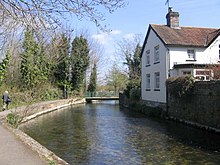Dorchester, Dorset
The Romans established a garrison there after defeating the Durotriges tribe, calling the settlement that grew up nearby Durnovaria; they built an aqueduct to supply water and an amphitheatre on an ancient British earthwork.
[4] Durnovaria was recorded in the 4th-century Antonine Itinerary and became a market centre for the surrounding countryside, an important road junction and staging post, and subsequently one of the twin capitals of the Celtic Durotriges tribe.
[9] Near the town centre is Maumbury Rings, an ancient British henge earthwork converted by the Romans for use as an amphitheatre, and to the north west is Poundbury Hill, another pre-Roman fortification.
The town became known as Dornwaraceaster or Dornwaracester, combining the original name Dor/Dorn from the Latin and Celtic languages with cester, an Old English word for a Roman station.
In the later medieval period the town prospered;[16] it became a thriving commercial and political centre for south Dorset, with a textile trading and manufacturing industry which continued until the 17th century.
[16] Only a few of the town's early buildings have survived to the present day, including Judge Jeffreys' lodgings and a Tudor almshouse.
[21][22] In the 17th century the town was at the centre of Puritan emigration to America, and the local rector, John White, organised the settlement of Dorchester, Massachusetts.
The first colonisation attempted was at Cape Ann, where fishermen who would rejoin the fishing fleet when the vessels returned the next year, tried to be self-sufficient.
[25] The town was heavily defended against the Royalists in the civil war and Dorset was known as "the southern capital of coat-turning", as the county gentry found it expedient to change allegiance and to swap the sides they supported on several occasions.
Dorchester Prison was constructed in the town during the 19th century and was used for holding convicted and remanded inmates from the local courts[30] until it closed in December 2013.
[38] The enclosures were followed by a series of key developments for the town: the enclosing of Poundbury hillfort for public enjoyment in 1876, the 'Fair Field' (new site for the market, off Weymouth Avenue) in 1877, the Recreation Ground (also off Weymouth Avenue) opening in 1880, and the Eldridge Pope Brewery of 1881, adjacent to the railway line to Southampton.
Salisbury Field was retained for public use in 1892 and land was purchased in 1895 for the formal Borough Gardens, between West Walks and Cornwall Road.
[38] Poundbury is the western extension of the town, constructed since 1993 according to urban village principles on Duchy of Cornwall land owned by Charles III.
Transition Town Dorchester is a community response to the challenges and opportunities of peak oil and climate change.
On the town seal, the royal purple background represents Dorchester's status as part of the monarch's private estate, a position held since before the Domesday Book was published.
The fleur-de-lis have a scattered arrangement which shows that permission for the armorial bearings was given before 1405, after which date the rights were varied by King Henry VI.
[47] Dorchester town centre is sited about 55 to 80 metres (180 to 262 ft) above sea-level on gently sloping ground beside the south bank of the River Frome.
There are over five hundred ancient monuments along the chalk hills that form the ridgeway, including barrows, stone circles and hillforts; many archaeological finds from the area are on view at the Dorset Museum in Dorchester.
[52] The geology of the town comprises bedrock formed in the Coniacian, Santonian and Campanian ages of the Late Cretaceous epoch, overlain in places by more recent Quaternary drift deposits.
57% of jobs were in public administration, education and health, 18% were in professional and market services (including finance and ICT), 17% were in distribution, accommodation and food, 4% were in production and 2% in construction.
[57] The Brewery Square redevelopment project now includes retail outlets, residential units, bars, restaurants, hotel and cultural facilities.
[58] The Charles Street development has had a first phase completed that includes a library, adult education centre and offices for Dorset Council.
[64] William Barnes, the West Country dialect poet, was Rector of Winterborne Came, a hamlet near Dorchester, for 24 years until his death in 1886,[65] and ran a school in the town.
[69] Then, after returning from America in June 1934, he had lived at 38 High East Street, Dorchester, from October 1934 until July 1935, when he moved to Wales.
[84] The building has changed little since the 19th century, and in 2014 planning permission was granted to transform it into a heritage centre and tourist attraction, to open in 2017.
It offers a twenty-four-hour accident and emergency treatment with services being provided by Dorset County Hospital NHS Foundation Trust.
Harry Redknapp and former England players Graham Roberts and Martin Chivers represented 'The Magpies' in the late 1970s and early 1980s.
Dorchester RFC is an amateur rugby union team who currently play in the Dorset & Wilts South 1 League.
National Express and Megabus operate long-distance coach journeys stopping at Dorchester with destinations including London Victoria and Weymouth.
[105] The town is part of the second phase of Superfast Dorset, a project to increase fibre broadband availability within the county, which has been completed.










